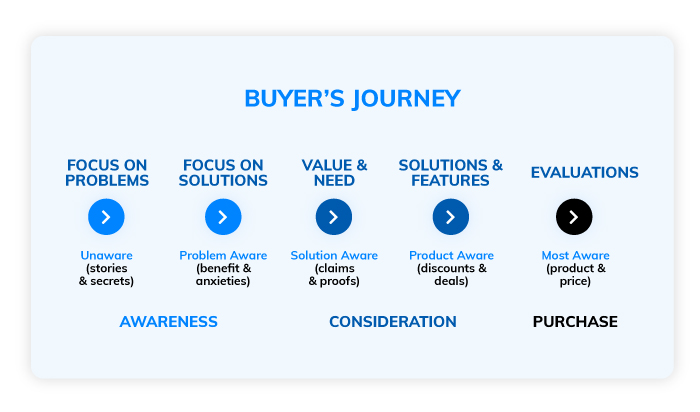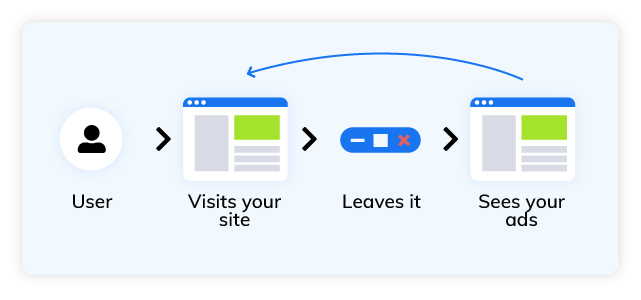[display-name-category]
[post_author]
[wtr-time]
Companies should consider each stage of the buyer’s journey to capture leads in different phases leading to a purchase. But, what is the buyer’s cycle, and why is each stage so critical to a content strategy?
What is The Buyer’s Journey?
The buyer’s journey or marketing funnel is a roadmap that visually helps brands identify the steps of the process that converts a prospect into a customer. It also helps brands understand the emotional steps that lead (or fail) a customer to buy.

The journey has three stages: Awareness, Consideration, and Purchase.
It begins with the awareness that there is a need. Then comes evaluation—what is the best way to proceed? The end is a decision that comes from this evaluation.
How Does This Relate to PPC?
Any PPC agency like White Shark Media leverages the buyer’s journey to keep costs down and ads strategic. For your PPC campaigns to be a success actions are required. A search, a click, a purchase.
Addressing a client’s needs at the right moment can be the reason they act.
Although the stages of the marketing funnel should be considered in everything that you do, they will do loads for your PPC campaigns. These days, no one has an unlimited budget for thoughtless marketing.
Linchpin stresses that “all businesses should keep the buyer’s journey in mind as they start to plan their website design and marketing initiatives such as Google SEO or content creation.”
Why is Each Stage of the Buyer’s Journey Critical?
Stage 1: Awareness
Prospects know that they have a problem, they want to solve it, and you want to help them relate that to your brand or service. This phase is when you educate the prospect.
- Objective: If they aren’t already aware, it’s your job to create it. They have a pain point and there is a business (yours) that can help solve it. Attract potential customers through solutions to these pain points.
- Currently: Researching for more information, will eliminate vendors that do not provide the functionality or services they seek.
- PPC ads for Stage 1: Display Ads
Stage 2: Consideration
If a prospect is searching for your brand and comparing it to others, you’ve captured their attention. Can you solve their problem? Is the information to this question out there? Create it! Help your eager customers determine whether your brand or services match their needs.
Gartner research shows that “customers who perceived the information they received from suppliers to be helpful in advancing across their buying jobs were 2.8 times more likely to experience a high degree of purchase ease, and three times more likely to buy a bigger deal with less regret.”
They are searching; they want to know how you stand above the rest—tell them!
- Objective: Aim to be helpful and trustworthy to position your brand as the best option. Answer questions and useful information.
- Currently: Asking questions and comparing prices.
- PPC ads for Stage 2: Remarketing ads

Stage 3: Purchase
A prospect in this final stage is just about to take action. Have you ever been on the edge of a mood and suddenly something pushes you over? This is that moment. The right (reassuring) words can push you over the edge.
- Objective: Help your prospect make a final decision.
- Currently: Conduct search queries with keywords; they’ve most likely reached out and are in final discussions.
- PPC for Stage 3: Keywords that target “high-intent” for search queries and CTAs.
Need support in this final stage? Work on your communication to convert more leads.
Join our VP as he shares valuable tips that your team can add to your communication strategy to grow your agency and scale your portfolio.
What is the problem of not considering the stage of the marketing funnel?
Suppose Amy keeps getting bombarded about the newest health app. One ad after another, she reads advertisements that fall under Consideration. Information is everywhere, but Amy doesn’t feel that it’s relevant to her. There is no content on the blog or YouTube for her to gain awareness.
Amy is unaware that this health app is the cure to many of the everyday health issues she struggles to solve. She’s unclear on her problems and hasn’t connected with how Amy can use them.
Amy has fallen through the cracks. It’s harder to recover someone that has already made up their mind that a product or service isn’t for them.
We’ve all valued exposure. Many are investing in a more strategic dialogue. Will creating content for each of the buyer’s journey stages make a difference? Considering the scenario above, yes, it can.
Sure, loads of people see your brand, but will they know how you can help them? Without the right messaging, will they connect with your service or products? Once they’ve decided this, it’ll be a lot harder to change their minds. So, instead of going in circles, why don’t we start at the beginning of the buyer’s journey.
Qualifying Leads With the Buyer’s Journey
As a PPC agency, we speak to many clients that invest in prospective clients only to realize they are not for them. The more you know about the buyer’s journey, the easier it is to identify your target audience.
Conclusion
As you can see, the reasons to get comfortable with each stage of the buying process go on and on. The journey documents the series of steps that a prospect takes from beginning to end. You can guess as you go, or you can create content that speaks to your audience as they move from interested parties to loyal customers.
Learn about more strategies with White Shark Media. Follow our blog to learn how to apply to your digital marketing plans and boost sales.





